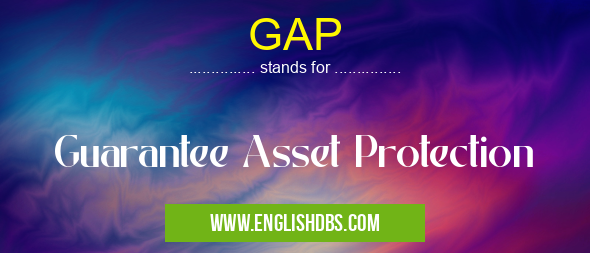What does GAP mean in BANKING
GAP is an acronym that stands for Guarantee Asset Protection. It is a type of insurance product, which provides protection against the financial losses resulting from unanticipated events such as accidents or natural disasters. GAP insurance covers a variety of assets such as cars, boats, recreational vehicles, and more. This coverage can help to ensure that owners will not incur significant out-of-pocket expenses due to these occurrences.

GAP meaning in Banking in Business
GAP mostly used in an acronym Banking in Category Business that means Guarantee Asset Protection
Shorthand: GAP,
Full Form: Guarantee Asset Protection
For more information of "Guarantee Asset Protection", see the section below.
What Does GAP Insurance Cover?
GAP insurance typically covers the difference in value between the actual cash value (ACV) of a vehicle and what the owner may owe on a loan if an unexpected event occurs and causes severe damage or total loss of the asset. In other words, it pays off any remaining balance on the loan that remains after an insurance claim is paid off by another source, such as comprehensive car insurance. It also covers new vehicle replacement costs in certain circumstances when a borrower cannot get financing to replace a totaled vehicle. For example, if you have an auto loan with a balance of $20,000 and the insurer only covers $18,000 due to depreciation or other factors, GAP coverage will provide up to $2,000 towards paying off the remainder of your loan. Therefore you can avoid having to pay out-of-pocket expenses for something you can’t drive anymore.
Who Needs GAP Insurance?
GAP insurance is beneficial for anyone who owns an expensive asset like a car or boat and has taken out financing on it. It is especially important for those who are making payments over long-term contracts since there could be considerable deprecation in value over time. Additionally, many lenders now require borrowers who take out loans on vehicles to purchase GAP coverage in order to receive financing. So if you're shopping around for auto loans make sure you ask whether this type of coverage is included in their terms and conditions before signing any documents!
Essential Questions and Answers on Guarantee Asset Protection in "BUSINESS»BANKING"
What is Guarantee Asset Protection (GAP)?
Guarantee Asset Protection (GAP) is a type of insurance coverage designed to cover the difference between what an insurance company pays for a total loss and what you owe on a financed or leased vehicle.
How does GAP Coverage work?
GAP coverage pays the difference between what your insurance company pays for a total loss and your outstanding loan/lease balance. It helps bridge the gap between those amounts so that you don’t have to pay out of pocket after a total loss.
Who Needs GAP Coverage?
Anybody who leases or finances their vehicle is at greater risk of owing money on their vehicle after an accident, theft, or if they default on payments. So anyone who has taken out a loan to purchase their car should consider getting GAP coverage.
What are some situations where GAP Coverage would be beneficial?
GAP coverage can be beneficial in cases when the market value of your car drops below the amount you owe on your loan/lease, such as if the car were stolen or totaled in an accident, or if you defaulted on payments and repossessed by the lender. In these instances, GAP coverage can help make sure you don’t end up owing money on a car you no longer have.
Is there more than one type of GAP Coverage?
Yes, there are two main types of GAP coverage – Return to Invoice and Finance Gap. Return to Invoice covers your original invoice price plus any taxes, fees, and government charges – minus any excess mileage fees on lease vehicles – while Finance Gap covers only what you currently owe on your loan/lease with no additional costs covered.
Do I need both types of GAP Coverage to be fully covered?
Not necessarily; it depends on which type of policy will best suit your specific needs. Generally speaking, Return to Invoice is better for people who want maximum protection as it covers more than just what is owed on your loan/lease balance.
How much does it cost?
The cost depends on various factors such as vehicle model & make and term length but typically 8-10% of premium rate applied towards inventory financing or lease up front payment protection benefits per year may apply depending upon the insurer offering this benefit under its product portfolio.
Does my auto insurance cover this type of gap?
No, auto insurance does not typically provide gap coverage; it usually only provides protection that covers damage or theft related to insured events.
How do I get started with purchasing Gap Insurance?
You can start by talking with an independent agent about your needs and evaluating different offers from different insurers to see which one best meets your requirements. You may even be able to bundle other insurance policies with gap insurance for added discounts.
Final Words:
Overall, GAP insurance provides valuable protection against losses associated with unforeseeable events like accidents or natural disasters which may result in heavy financial burdens otherwise incurred by owners without this coverage. Knowing what it does as well as whether or not your lender requires it should help make determining whether or not you need GAP coverage easier!
GAP also stands for: |
|
| All stands for GaP |
